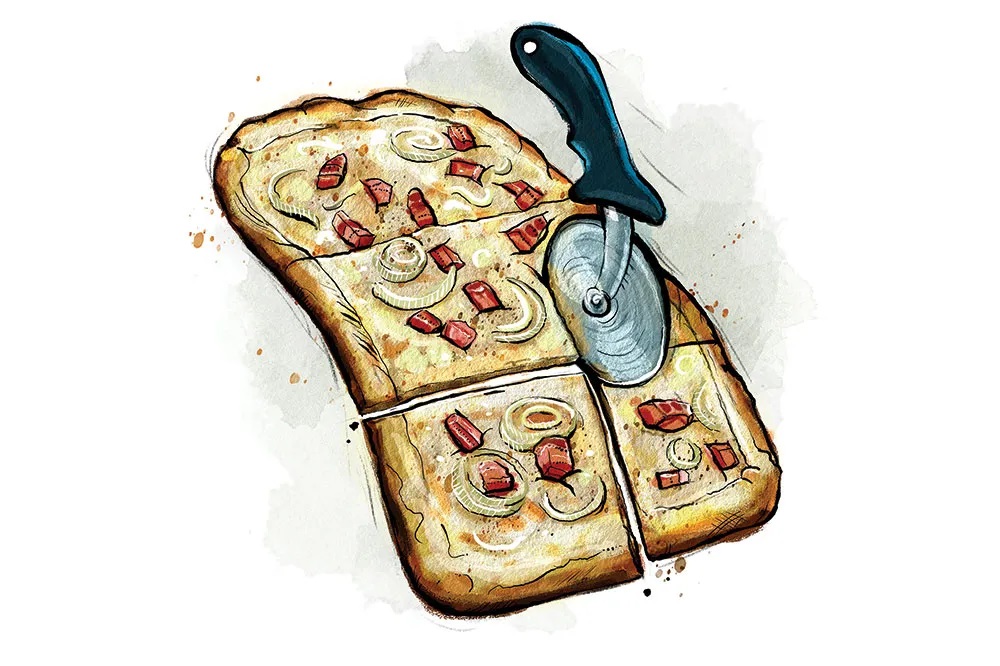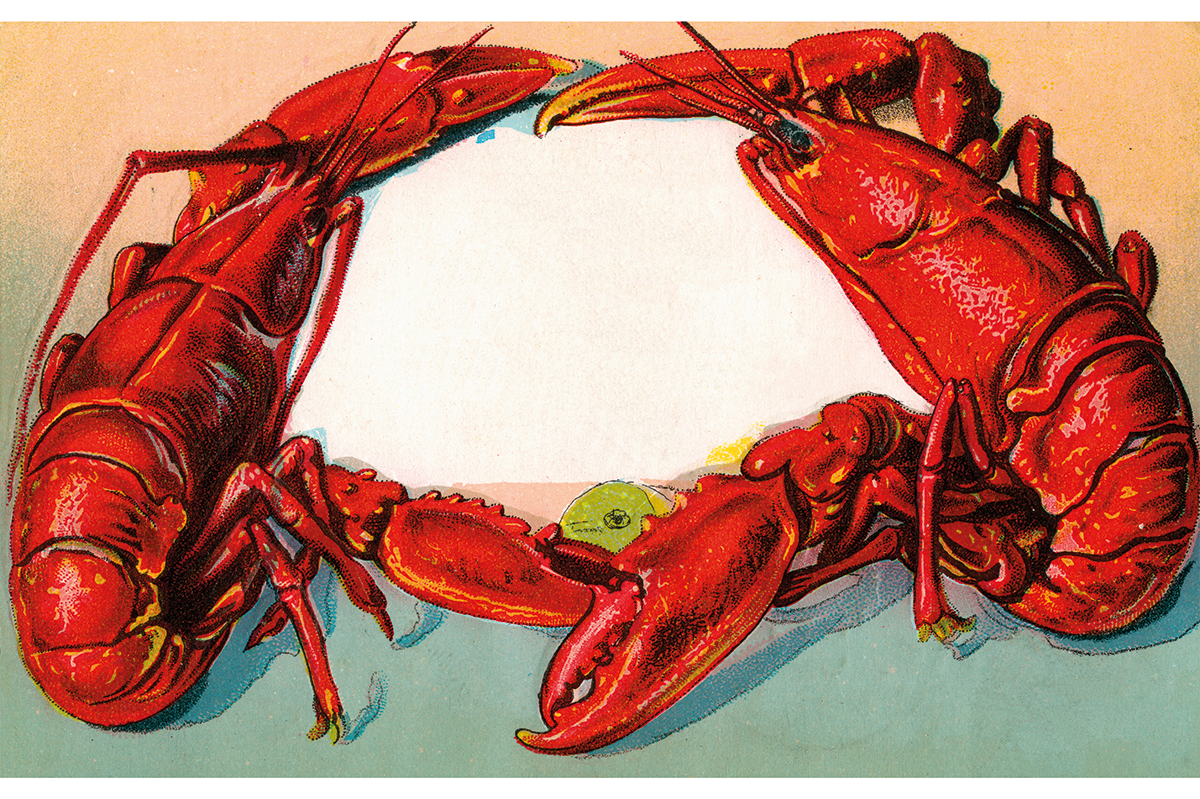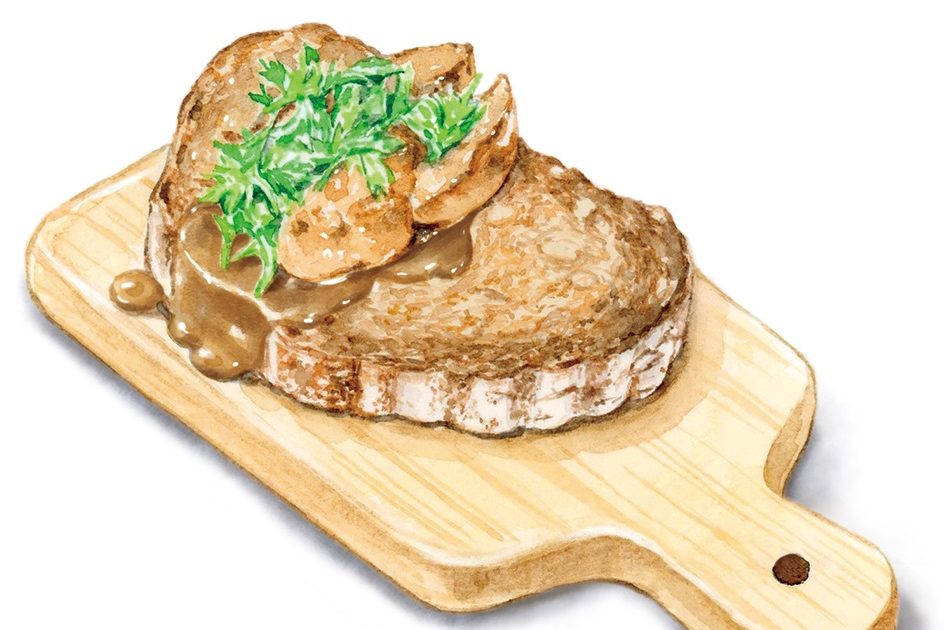There are times in the year that call for snacks. Rather than embracing the various diets and other forms of self-flagellation that sweep over us at the start of the year, we need every joy we can get during endless January, with its dark, short days and cold nights. Right now, we are in such territory. Open those chips, order the fries, invite joy in.
I have strong ideas about the platonic snack for winter: something hot, ideally, to accompany a glass of something cold as you while away the dark evenings. The ideal contrast between crisp and yielding, sweet and salty — something that can be picked up one-handed and is substantial enough to satisfy, but still leave you wanting more. Flammekueche fits the bill pretty well.
We need every joy we can get during January and this is my idea of the perfect snack for winter
Flammekueche is a speciality of the Alsace region: a rectangle of dough, topped with onions, bacon and crème fraîche. Outside of the main regions, it is often known as tarte flambée — which is slightly misleading, as it is neither flambéed (set alight with alcohol) nor really a tarte. It’s more of a pizza, if we’re being honest, although I wouldn’t let either the Alsacians or the Italians hear you say that. Supposedly a flammekueche would be used to test the heat of the farmers’ wood-fired ovens, as it would cook very quickly when these were hot enough.
There are a couple of variations among flammekueche aficionados: it can be made with a leavened or unleavened base; thin and crisp, or thicker and breadier. Michel Roux makes his with puff pastry, but I agree with Felicity Cloake who thinks that this turns the flammekueche into “just another tart,” which it definitely is not. I’d rather have a flammekueche than not, so in a pinch, shop-bought puff will do the job, but I’d urge you to give making the dough a try. It comes together quickly, doesn’t require proving, and — despite the rich toppings — really gives the dish its distinctive character.
For my money, flammekueche should have the thinnest of bases, crisp and almost flaky. Crème fraîche or (if you have access to the proper French stuff) fromage frais are spread on the raw base; if you can, splash out and use the fancy, thicker varieties of either. This is then topped with salty cured pork and tangles of onion: I like the pork in the form of little chunky lardons (rather than in rashers or slices), which have been cooked from cold until the fat renders and they turn golden. The onion also benefits from a quick softening before it is added to the base. The whole thing is cooked hot hot hot, until the base crisps and the onions just begin to char.
Rick Stein adds gruyère to his flammekueche (which, if we’re getting technical, actually turns it into a flammekueche gratinée). I’m not sure I’ve ever deliberately eschewed cheese on, well, any dish, but this might be the exception. Having tried it both ways, I think that grated gruyère sprinkled on top is delicious, but it also changes the whole taste. It has the tendency to outshine the other elements, which otherwise complement each other. And the trio of rich crème fraîche, sweet onion and salty pork truly don’t need anything else.
For all my snack evangelism, flammekueche does hold its own as a meal, with nothing really needed to accompany it apart from a green salad dressed with something sharp and mustardy, and perhaps a handful of small pickles. But for me, its speediness, its thinness, its salty sweetness, make it the perfect pre-dinner appetizer. Either way, if you’re lucky enough to have a pizza oven, these thin tarts can be cooked in under two minutes; in a domestic oven, you’re going to need to be a little more patient, but they will still be ready in under a quarter of an hour. This is fast food.
Lift the finished flammekueche out onto a breadboard, cut it into big, generous squares or slabs, plonk it down with a bottle of wine, and remind yourself that even the darkest months can be brightened in this way.
Serves 4
Takes 15 minutes
Cooks 10-12 mins
For the dough
- 1 cup plain flour
- ⅔ cup water
- 2 tbsp olive oil
- 1 tsp salt
For the filling
- ⅞ cup smoked lardons
- 1 onion, peeled and sliced
- ⅞ cup crème fraîche
- 1 oz butter
- First make the dough. Place all the ingredients in the bowl of a stand mixer with a dough hook, and knead for about five minutes, until smooth. You can do this by hand, but it will take a few minutes longer. Leave the dough to rest while you prepare the other ingredients
- Place the lardons in a dry, cold frying pan, and cook over a medium heat until the fat has rendered and the lardons are golden. Lift from the pan with a slotted spoon and set to one side. Turn down the heat, add the butter and sliced onions, and cook until the onions are softened but not colored
- Heat your oven as high as it will go
- Roll the dough into two rectangles, each measuring about 10×11 inches, and lift onto two large, lined baking trays. Gently straighten out the dough on the tray if it has become rucked up
- Spread each rectangle with ⅔ cup crème fraîche, leaving a thin border on all edges. Scatter over the onions and the lardons, and then cook for 10-12 minutes, until the edges of the dough are golden brown, and the onions are just starting to catch. Remove from the oven, cut into squares and serve
This article was originally published in The Spectator’s UK magazine. Subscribe to the World edition here.


























Leave a Reply